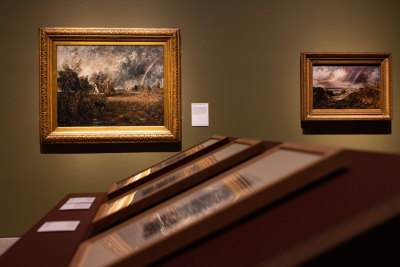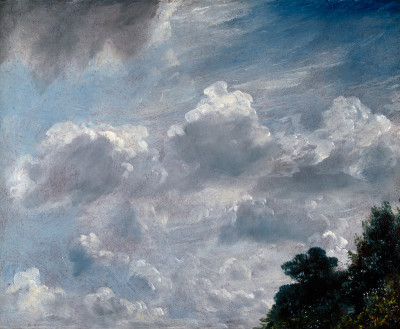Artist of the Month: August 2014
Artist of the Month: August 2014
George Clausen RA
By the RA Collection team
Published 7 August 2014
George Clausen is remembered for the range of his remarkable accomplishments, both as an artist and as a dedicated Member of the RA.
-
When he died, at the grand old age of 92, the artist Sir George Clausen RA was remembered for an astonishing number of achievements. Among these were the lectures he presented to students at the Royal Academy Schools between 1904 and 1913, his role as war artist between 1914 and 1918 and his commitment to Academy reform, which had begun with his membership of the New English Art Club in 1886.
Born in London, Clausen’s artistic talent was encouraged by his Danish father, who was an interior decorator. A scholarship at the National Art Training Schools in South Kensington was followed by a brief period of study on the continent in Antwerp and Paris. Studies relating to visits to Belgium and Holland appear in Clausen’s sketchbooks from the summer of 1874 and he began to exhibit Dutch subjects in London in the same year until 1883.
While studying at the Antwerp Academy in the 1870s, Clausen made frequent sketching trips in Belgium, Holland and Northern France. Among other subjects, he focused on Dutch peasants, as seen in Study of a young Dutch boy. The pin holes in the corners of the canvas indicate that it was probably supported on a board, the work painted directly in front of the motif.
-

George Clausen RA, Study of a young Dutch boy, 1870s.
Oil on canvas. © Royal Academy of Arts, London.
-
In 1881, Clausen married and moved from London to Childwick Green in Hertfordshire, painting the rural activities from the area in the manner of the French plein air artist, Jules Bastien-Lepage. View of a Lady in Pink standing in a Cornfield probably depicts Clausen’s young wife, Agnes Mary Webster, standing in a cornfield at dusk near their new home in the village of Childwick Green, where the couple moved soon after their marriage. Clausen has worked with square brushes in this sketch, a technique that he used from around 1880 following his contact with the work of Bastien-Lepage.
-

George Clausen RA, View of a Lady in Pink standing in a Cornfield, 1881.
Oil on canvas. © Royal Academy of Arts, London.
-
By 1889, Clausen had moved away from the influence of Bastien-LePage to develop his own form of Impressionism. Experimentation with pastel probably encouraged the luminous palette and fluid approach seen in works from this period. A Farmyard depicts a brightly lit farmyard scene with a lad carrying a bucket at the far left and chickens pecking in the dirt behind him. The paint application appears quite dry and chalky and has the effect of pastel, which is typical of Clausen’s technique at this time.
-

George Clausen RA, A Farmyard, 1893.
Oil on canvas. © Royal Academy of Arts, London.
-
These developments are also evident in the irridescent colouring and dramatic lighting of Clausen’s diploma work, Interior of an Old Barn. Inspired by the Essex countryside, which had been the subject of much of his work since 1891, Interior of an Old Barn is one of a series of barn interiors which Clausen produced from 1897 onwards. This painting was admired by contemporary critics for its atmospheric lighting. The chiaroscuro is pronounced, with the nearest figure seen only in silhouette. Perhaps influenced by his work in pastels, the painting is highly coloured, with light entering the barn from both the side and the rear, and blue highlights showing on the man and ground. The brushwork is free and uninhibited.
By 1908 Clausen no longer lived in the countryside but would regularly spend several weeks at a time sketching around Clavering in Essex. Often, as in this painting the figurative element in his work lessened, perhaps because he no longer had the opportunities to observe labourers at work all year round. A sketch in the Royal Academy collection shows that Clausen was particularly concerned with the pose of the man leaning on a stick. When the painting was first exhibited reviewers appeared to agree that Clausen’s Diploma work was a worthy variation on one of his favourite themes. The Art Journal noted that “Mr Clausen is no stranger to studies of this kind: but he introduces a deeper note.”
-

George Clausen RA, Interior of an Old Barn, 1908.
Oil on canvas. © Royal Academy of Arts, London.
-
During the First World War, Clausen had produced a number of large-scale allegorical works and in 1925, when he was aged 73, he was asked to contribute to a mural scheme to decorate St. Stephen’s Hall in the Palace of Westminster. The subject of Clausen’s mural was the secret readings of John Wycliffe’s Bible in 14th-century England. This full-length study, which relates to a figure at the centre of the composition, would have been drawn from life in Clausen’s studio from a model wearing historical costume.
These works by Clausen are included in the touring exhibition from the Royal Academy Collection Genius and Ambition: The Royal Academy of Arts, London 1768-1914 which is currently on show at Ishikawa Prefectural Museum of Art, Japan, until 31 August 2014.
-
See more by George Clausen RA in our Collection.







